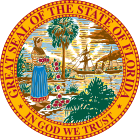Florida Senate
This article needs additional citations for verification. (February 2014) |
Florida Senate | |
|---|---|
| 2016-18 Florida Legislature | |
 | |
| Type | |
| Type | of the Florida Legislature |
Term limits | 2 terms (8 years) |
| History | |
| Founded | January 7, 1839 |
| Preceded by | Legislative Council of the Territory of Florida |
New session started | March 7, 2017 |
| Leadership | |
President pro tempore | |
Majority Leader | |
Minority Leader | |
| Structure | |
| Seats | 40 |
 | |
Political groups | Majority
Minority
|
Length of term | 4 years |
| Authority | Article III, Florida Constitution |
| Salary | $29,697/year + per diem |
| Elections | |
Last election | November 8, 2016 (40 seats) |
Next election | November 6, 2018 (20 seats) |
| Redistricting | Legislative Control |
| Motto | |
| In God We Trust | |
| Meeting place | |
 | |
| Senate Chamber Florida Capitol Tallahassee, Florida | |
| Website | |
| Florida Senate | |
 |
|---|
The Florida Senate is the upper house of the legislature of the U.S. state of Florida. Along with the House of Representatives, it composes the Florida Legislature. The Senate has 40 members, each elected from a single-member district with a population of about 470,000. The Senate meets at the State Capitol in Tallahassee.
Senators generally serve four-year terms and are restricted by term limits, barring them from running for re-election if they have served in office for the past eight consecutive years. This ordinarily limits senators to two four-year terms.
The Florida Constitution establishes the legislature’s powers and duties, which include passing laws, developing an annual state budget, and making investigations. Additionally, the Senate has the exclusive power to try officials impeached by the House, and to confirm some executive appointments.
The Senate has its origins in Florida’s territorial period, when the Florida Territorial Council was made bicameral in 1838.
Terms, qualification and districts
The Florida Constitution requires state senators to be elected to staggered, four-year terms.[1] Senators in odd-numbered districts are elected in U.S. presidential election years, while senators in even-numbered districts are elected in midterm election years. However, to reflect the results of the U.S. Census and the redrawing of district boundaries, all seats are up for election in redistricting years, with some terms truncated as a result. Thus, senators in even-numbered districts were elected to two-year terms in 2012 (following the 2010 Census), and senators in odd-numbered districts will be elected to two-year terms in 2022 (following the 2020 Census). All terms were truncated again in 2016, with all 40 seats up for election, due to court-ordered redistricting.
State senators must be at least 21 years of age, an elector and resident of their electoral district, and a Florida resident for at least two years prior to election.[1] They take office upon election.[1]
Powers and process
The Florida Constitution authorizes the state legislature to create and amend the laws of the U.S. state of Florida.[1] State senators propose legislation in the forms of bills drafted by a nonpartisan, professional staff.[2] Successful legislation must undergo committee review, three readings on the floor of each house, with appropriate voting majorities, as required, and either be signed into law by the governor or enacted through a veto override approved by two-thirds of the membership of each legislative house.[2]
The entire Florida Legislature meets every year in a session beginning on the first Tuesday after the first Monday in March and lasting 60 calendar days.[3] Special sessions may be called either by the governor or by the leaders of both chambers acting jointly.
Composition
| Affiliation | Party (Shading indicates majority caucus)
|
Total | ||
|---|---|---|---|---|
| style="background-color:Template:Republican Party (United States)/meta/color" | | style="background-color:Template:Democratic Party (United States)/meta/color" | | |||
| Republican | Democratic | Vacant | ||
| End of previous legislature | 26 | 14 | 40 | 0 |
| Begin (November 2016) | 25 | 15 | 40 | 0 |
| April 21, 2017[4] | 24 | 39 | 1 | |
| September 26, 2017[5] | 16 | 40 | 0 | |
| Latest voting share | 60% | 40% | ||
Leadership
| Position | Name | Party | District |
|---|---|---|---|
| President of the Senate | Joe Negron | Republican | 25 |
| President pro tempore | Anitere Flores | Republican | 39 |
| Majority Leader | Wilton Simpson | Republican | 10 |
| Minority Leader | Oscar Braynon | Democratic | 35 |
| Minority Leader pro tempore | Lauren Book | Democratic | 32 |
Members, 2016–2018
District map

See also
- Florida Legislature
- Florida House of Representatives
- Florida Senate Majority Office
- Government of Florida
- Office of Program Policy Analysis and Government Accountability
- The Florida Channel
- List of Presidents of the Florida Senate
- American Legislative Exchange Council members
References
- ^ a b c d Florida Constitution Online (accessed January 4, 2015)
- ^ a b Senate Handbook, 2012-2014, Florida Senate (accessed May 22, 2013)
- ^ Florida Senate (accessed May 22, 2013)
- ^ Republican Frank Artiles resigned after using profanities and racial slurs against fellow senators. Mazzei, Patricia; Klas, Mary Ellen (April 21, 2017). "Miami lawmaker resigns over racial slur scandal". Miami Herald. Retrieved April 21, 2017.
- ^ Democrat Annette Taddeo was elected to District 40. "Annette Taddeo victorious in hard-fought SD 40 special election". Florida Politics. September 26, 2017. Retrieved September 26, 2017.
- ^ And previous terms of service, if any.
External links
- The Florida Senate official government website
- State Senate of Florida[dead link] at Project Vote Smart
- Florida Senate at Ballotpedia

